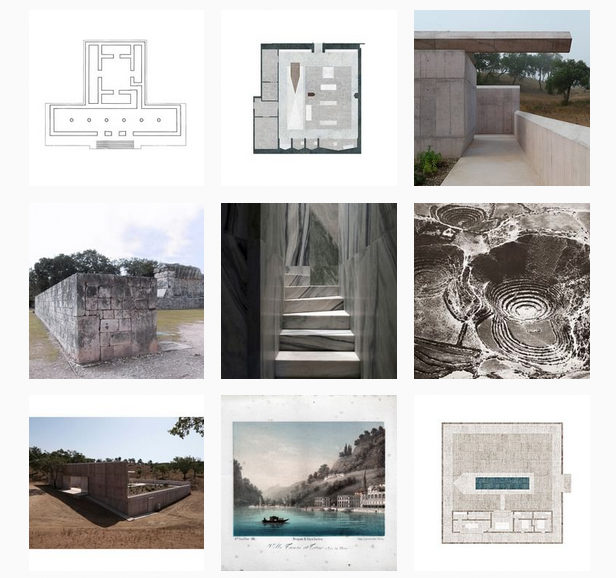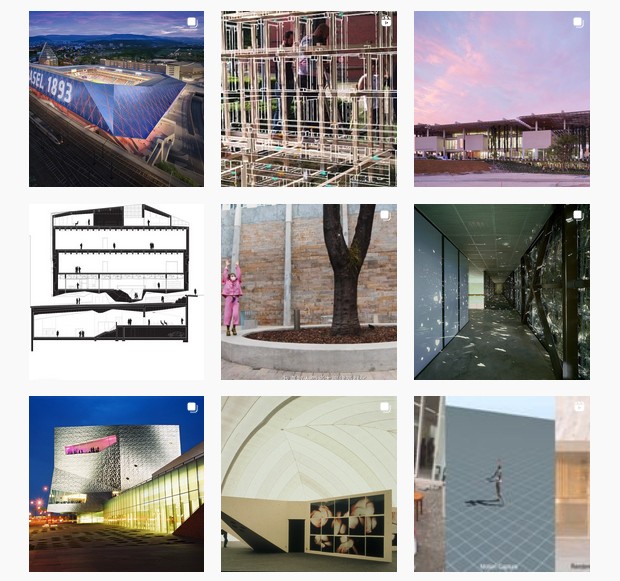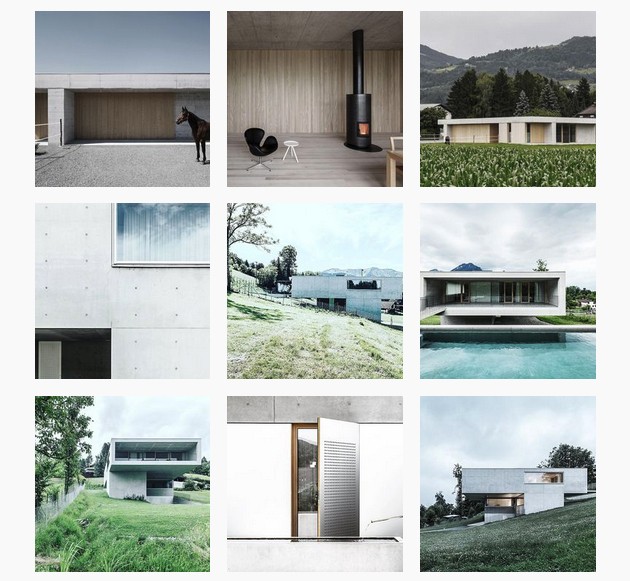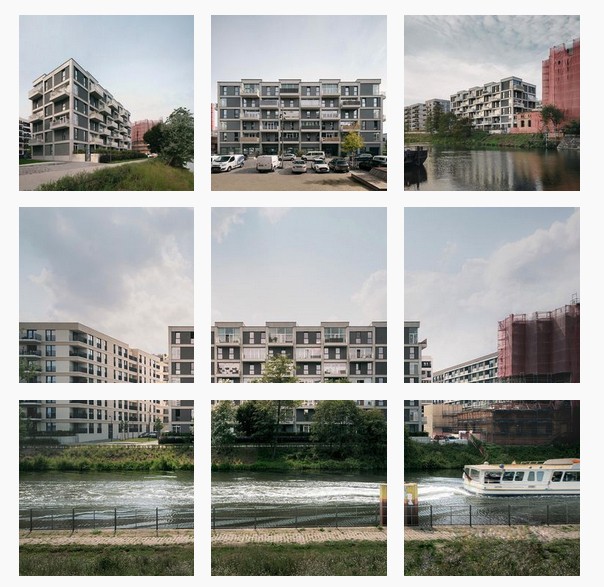With the digitalisation of communication across all industries, architectural communication has also changed fundamentally. The importance of social media, especially the image-heavy platform Instagram, is taking on an increasingly important role as a communication channel for architects as well. Some architecture offices were quick to recognise the potential of Instagram as a digital showroom for their work, while others have only recently joined.
By Ulrike Haardt and Serena Garulli.
What opportunities does an Instagram account offer architects, what benefits can be derived from a strong presence on social media at all? And is there a recipe for success for a high-reach profile that achieves relevance beyond the platform?
More than cats and celebrities: Instagram as a visual mouthpiece for a personal understanding of architecture
On Instagram, users worldwide produce millions of pictures and videos every day that find their way into public. The platform is considered the most superficial of all social media. Nevertheless, it is a global image archive in which every conceivable topic can be tagged and found by hashtag. For architects, this is highly relevant and usable from different perspectives: as a research tool for materials and building products, as a source of inspiration in the design phase and as a discussion platform within the industry. The platform is also suitable as a channel for one’s own PR, for the presentation of current projects, for addressing target customers and potential clients and, last but not least, as a place for employer branding and for the search for new employees. As a digital business card, Instagram is increasingly influencing the perception and image of architects and their offices. Once they have gone viral, reel and story formats can ensure a strong presence in the short term, the relevant impact of which is transferred to the analogue world.

Architects are increasingly using the opportunity to creatively design their own profile in order to present their working methods, personal understanding of architecture and theoretical position to the public. In contrast to trade magazines, industry journals or architecture blogs, the offices can act completely independently here, without “censorship” by the layouter or the editor. On Instagram, architecture as an image-rich topic meets a highly agile global community. The great skill, however, is to make yourself heard with a profile that has a wide reach.
The Instagram profile as a conceptual statement
The Swiss architect Valerio Olgiati (@valerioolgiati) is known for the special attitude that connects his architectural works in terms of content. His profile on Instagram also conveys a calm, unspectacular aesthetic through his choice of images and layout. The alternation of photographs, drawings and material details is carefully curated into an overall image that reflects Olgiati’s principles of simplicity and efficiency. It is not about effects and imposing size, but about a reduced visual language: his buildings are mostly shot frontally, there are few over-corner perspectives, details such as floor tiles or even sketches are shown strictly from above.
Additional information is dispensed with; apart from a vague indication of the location, there is no text: The focus is on form. Olgiati’s concept of order in building is thus basically reflected in his Instagram strategy. With 184,000 followers, the architect has a large community of fans for his conceptually oriented account. While his own website does not provide any visual insights and only mentions the address and contact details of the office, the fixed tile grid of Instagram seems to offer the architect the right framework for a visual presentation of his work.
The more the merrier: Large architecture firms on Instagram
If you take a look at the big architecture offices on Instagram, it immediately becomes clear: here, it’s not primarily about a visual profile overall picture, where the new post has to fit the last one compositionally. There is a lot of building going on and therefore a lot to show. With 502,000 followers, Herzog & de Meuron (@herzogdemeuron) is one of the widest-reaching architecture firms on Instagram. They post regularly: spectacular views, skylines, interiors, drawings and plans, renderings, construction sites, people, nature. All posts are enriched with correspondingly detailed information about the respective project and participating partners are added. The website’s link tree URL in the Instagram bio drives traffic by topic and makes it easy for users to find their way around.
Further examples of this colourful, varied use of an individual channel can be found at many other large, internationally active architecture firms such as Snohetta, Zaha Hadid, Renzo Piano, David Chipperfield, Daniel Libeskind etc. Posting on Instagram takes place here on a professional level, obviously ties up corresponding personnel power and is a natural part of the mix of marketing, branding and reputation.

Can we learn from the architectural communication of the greats? A lot goes a long way – this also applies to Instagram, whose algorithm needs to be constantly fed. And the community is also hungry for new images, inspiration and entertainment. Posting often and regularly is the motto – this has become a truism, but it is still true and worth the effort.
Focus on brand identity: Clearly visualise your own brand message
Like their own website, more and more architecture offices are using Instagram as a digital platform to visually present their own brand. Accessing an Instagram profile is comparable to entering a visual showroom – the appearance as a whole bears the brand’s signature and conveys its core elements.
from Austria also succeeds in creating a uniform image and form language on Instagram that emphasises their brand identity. The colour scheme is cool and high-contrast thanks to a blue filter, and the building projects are presented as a series with interior and exterior views in several posts one after the other. Materiality and textures are the focus in both the architectures and their visualisations.
Both examples show that Instagram is not only used as a series of beautiful pictures, but the overall appearance is understood and implemented as a composed exhibition – with success, because the number of average likes is high.

Instagram opens up the view behind the projects: It’s also allowed to be human
Instagram opens up the view behind the projects: It’s also allowed to be human
It is common knowledge that the architecture industry suffers from a shortage of skilled workers. It is therefore not surprising that Instagram profiles of architects increasingly focus on the people behind the projects. The message of digital employer branding on Instagram is: Look, we have exciting projects and a great team. The Berlin architecture office Kinzo (@kinzoberlin) has a bright, colourful and friendly profile with a white frame layout throughout, reports on activities beyond pure architecture projects and introduces its own employees in its post series “people@kinzo”. Stories from the team with the corresponding faces – it’s okay to show your human side on Instagram. The Munich studio for interior design INpuls (@inpulsinterior) succeeds in creating a harmonious mix of project photos and employee portraits without losing sight of the design requirements for the aesthetic and content-related impression of the profile. Numerous architecture firms also use the story format to place their job offers: as the story highlight “Jobs”, they are prominently visible under the profile details in the series of story archives.
Visibility and independence: where the effort pays off

Is there a recipe for success for architectural communication on Instagram? Yes and no. The cross-industry do’s and don’ts on Instagram also apply to architecture offices: post regularly and often, show good images, present a coherent overall concept, offer variety through different content (work photos, drawings, model views), use well-researched hashtags, tag involved parties and partners, motivate comments and be in exchange with the community – architects should also do all this for their Instagram profile. The architecture industry in particular is dependent on images and visualisations – they not only shape the perception of the building, but also the aesthetics on Instagram. At first glance, many of the accounts of the large offices seem similar in their appearance and thus interchangeable; however, they are very successful with this. The large architecture community on Instagram rewards spectacular, “catchy” images with likes and positive comments. However, not every architecture firm builds large museums or sensational headquarters and can score points on social media with them.
It is interesting to observe that younger offices in particular stand out with their own conceptual strategies: The Berlin architects Drei Gegen Einen (@dreigegeneinen) sometimes dare to make a rather unattractive typography post, the profile of the Leipzig studio ST (@atelierst_architects) opens up like a magazine, Zander Roth Architekten (@zanderrotharchitekten) sometimes use up to eight post tiles for one motif – this does not bring many ad hoc likes, but it does reveal the architects’ design will and conceptual-strategic thinking.
The diversity of architects’ accounts on Instagram is great. As a visual platform, Instagram is particularly suitable for bringing architectural projects and their context to the public. Unlike any other medium, the designing architect can decide autonomously which of his or her works is to be shown and how.
More on ndion
More articles on brands.
Share this page on social media:

